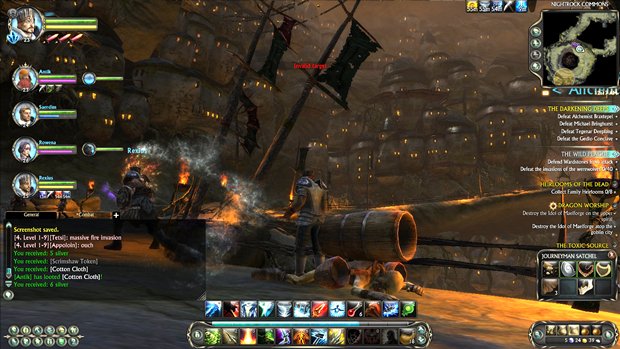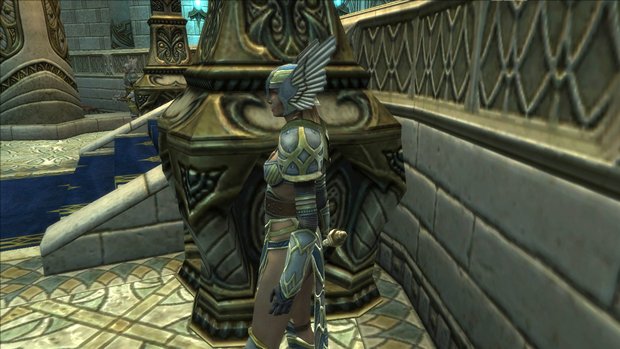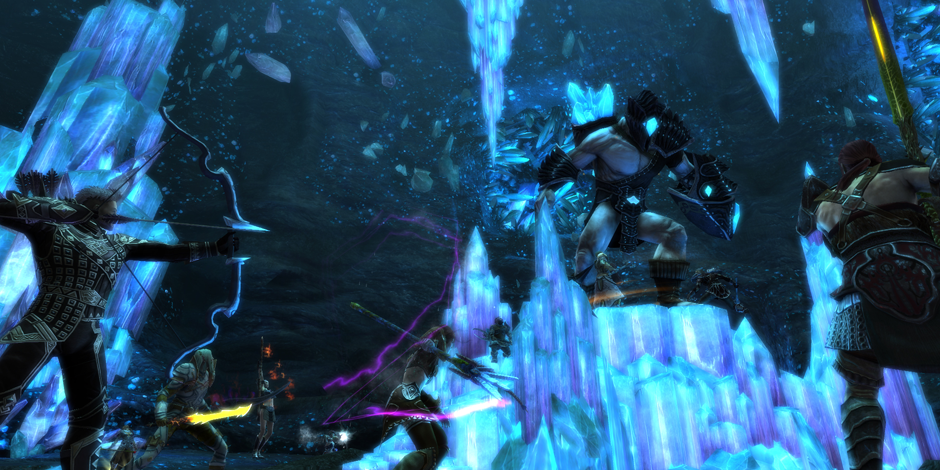Why you can trust GamesRadar+
Above all, the constant rifts and invasions ensure that no two visits to a particular zone ever seem the same, and this may spell success for Rift once most of its initial players reach the level cap in the coming days. Yet while closing your first rift with a bunch of other players counts as one of the few truly awesome MMO experiences these days, the experience quickly gets repetitive and downright boring after only a few times. By Level 30, we found ourselves getting annoyed by all the rifts in one zone, particularly when no one rushed to close them and the rift stood right on top of our questing spot. And since quest progression is often brutally linear, this could stop you in your tracks until the rifts despawn or some buddies help you close it.

Above: Not your average five-man dungeon scenery
In our experience, the instanced dungeons are beautiful if a bit easy. As Guardians, we started off with the Realm of the Fae dungeon, which kicks off in a forest but surprisingly ends atop a snowy peak. In the next, the Darkening Deep, we raced through an underground goblin city and faced off against a werewolf and a gigantic spider. The problem? None of the instances seemed particularly challenging. Even with random players, we never once really talked about strategy with the groups we were in, and we usually adjusted to unexpected strategies on the fly. It doesn't look like it'll improve much at endgame aside from some spikes in challenge. Case in point: You get a chance to partake in two tiers of "expert" dungeons (read: heroic) at Level 50, but most of these are mere repeats of the same instances you played through at earlier levels.
PVP is fun, if a little predictable. As the game stands, you never know what kind of build enemy players will have thanks to the huge variability of the class/soul system, and this diversity alone makes PVP fairly balanced for now. Unfortunately, Rift completely missed the chance to make its PVP "warfronts" truly innovative by using something like its rift concept; instead it slavishly lifts ideas from World of Warcraft's battlegrounds. Again, it does this well, but here the borrowings sting most of all. The Level 50 warfront Port Scion seems like an early version of WoW's Alterac Valley; the Codex bears striking similarities to Arathi Basin, a king-of-the-hill type battleground; and the Black Garden is a capture-the-flag affair reminiscent of Warsong Gulch. To be fair, there are flashes of originality here. In Black Garden, for instance, the shard that passes for the "flag" eats health from the carrier (although others will recognize this as an import from Warhammer).
But at least the world looks cool. In fact, Rift's landscapes are often extraordinary. Among the early highlights we encountered on the guardian side were Gloamwood, a Transylvania-style zone complete with dreary villages and a gargantuan Stonehenge-style monument, and Scarlet Gorge, which looks like a mishmash of the Old West and the Lord of the Rings. Even the two faction cities are stunning (if a bit small and confusing), and the immense detail in almost every object radiates on even the lowest settings.

Above: No DD cups? Rift is more innovative than we thought
Yet Rift's presentation isn't perfect. Something about the combat seems a little flat and unsatisfying. Using the auction house is an ordeal, and even the primary game font seems hard to read at times. The audio in particular is weak: while there's nothing wrong with Inon Zur's commendable score (and we especially liked the transitions to "battle music" when we entered combat), sound in general seems strangely muted and sword fights yield almost none of the steel-clanging action that gets our blood going.
Listen, fanboys: Rift is not a WoW-killer. At best it offers some healthy competition that should slam some innovation into Blizzard's overly comfortable development team; at worst it seems a little too derivative even with the undeniable polish. But it's refreshingly stable. Not once did we see a server crash - even at peak hours when rifts and invasions were as thick as protesters in Madison - and server queues have all but disappeared in the days since release. As it stands, Rift is an excellent title for MMO fans seeking a change of scenery while sticking to familiar concepts, even if they only play up to the current level cap of 50. It's fresh, it's new, and it's unburdened by endless strategy guides and add-ons that might as well be called cheats. (In fact, Rift doesn't even allow third-party mods.) Most importantly, it's fun.

Above: Mods? Where we're going, we don't need mods
Above all, Rift needs to prove it can offer far more beyond 50. Trion's baby already shows some promise of being the most successful MMO release since World of Warcraft, but the endgame currently stands as a looming question mark that overshadows everything else. Worse, since so much of it currently seems based on the rifts themselves, we question how long the novelty will survive the brief bouts of irritation we experienced after chasing down the twelfth rift in one zone. For now, though, enjoy the ride. We suggest you use Rift to get your MMO fix while Cataclysm releases yet another patch of regurgitated content and Guild Wars 2 polishes its armor in the far horizon. It might not be the greatest MMO of all time, but it suffices brilliantly.
Mar 11, 2011
More info
| Genre | Role Playing |
| Description | With endless rifts that constantly alter zone dynamics and one of the most complex class systems we've ever seen, Rift is a welcome breath of fresh air in the fairly stagnant world of MMORPGS. Now it faces the challenge of offering the same great experience for its endgame. |
| Platform | "PC" |
| US censor rating | "Teen" |
| UK censor rating | "" |
| Alternative names | "Rift: Planes of Telara" |
| Release date | 1 January 1970 (US), 1 January 1970 (UK) |



